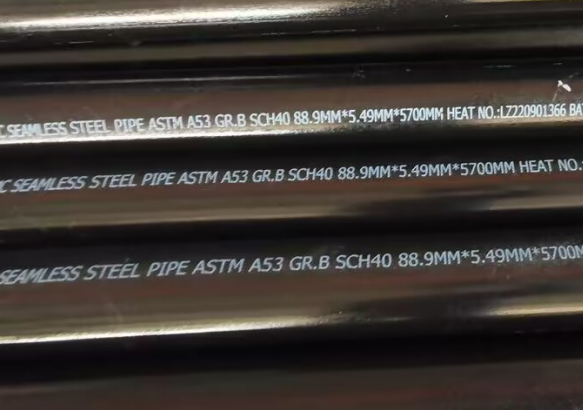
What is ASTM A53 pipe?
What is ASTM A53 black carbon steel pipe?
ASTM A53 black carbon steel pipe, also known as ASME SA53 pipe, is an excellent candidate for most processing. Features a semi-smooth surface painted in black. Black steel pipe is suitable for mechanical and pressure applications. Common applications include steam, water, air and gas systems. ASTM A53 is the standard specification covering seamless and welded, black and hot-dip galvanized nominal (average) wall pipe for coiling, bending, flanging and other special uses, and is suitable for welding. A53 Bare steel pipe size consists of two non-dimensional numbers. Nominal pipe size (NPS) or inside diameter (ID), and pipe specification (SCH) which refers to wall thickness.

Characteristics and applications of ASTM A53 black carbon steel pipe:
The ASTM A53 specification for black steel pipe outlines its characteristics and common applications. The following are some features and applications of ASTM A53 black steel pipe:
1. Characteristics of ASTM A53 black carbon steel pipe
Material: ASTM A53 Black Steel Pipe is made of carbon steel for durability and strength.
Coating: It is non-galvanized and usually has a black coating to prevent rust and corrosion.
Weldability: Suitable for welding, threading and grooving, suitable for various installation methods.
Dimensions: Available in various sizes and thicknesses to meet different industrial and construction requirements.
2. Application of ASTM A53 black carbon steel pipe
Water Transmission: Used for gas transmission and distribution in various industrial and municipal applications.
Structural Use: Typically used for structural support in construction and infrastructure projects.
Mechanical components: Used in the manufacture of mechanical components such as handrails, fences and scaffolding.
Oil and Gas Industry: Widely used in the oil and gas industry for transporting fluids and gases in pipelines.
Hot-dip galvanized ASTM A53 black carbon steel pipe:
ASTM A53 pipe hot dip galvanizing treatment steps
ASTM A53 pipe → degreasing → water washing → pickling → water washing → dipping solvent → drying and preheating → hot dip galvanizing → finishing → cooling → passivation → rinsing → drying → inspection.
Reasons for hot-dip galvanizing of ASTM A53 pipes
(1) Low processing cost
The cost of hot-dip galvanizing for rust prevention is lower than other paint coatings;
(2)Durable
In suburban environments, standard hot-dip galvanized anti-rust coatings can last for more than 50 years without maintenance; in urban or offshore areas, standard hot-dip galvanized anti-rust coatings can last for 20 years without maintenance. ;
(3) Good reliability
The galvanized layer is metallurgically combined with the steel and becomes part of the steel surface, so the durability of the coating is relatively reliable;
(4) The coating has strong toughness
The galvanized layer forms a metallurgical structure that can withstand mechanical damage during transportation and use;
(5)Comprehensive protection
Every part of the plated parts can be galvanized, even in recesses, sharp corners, and hidden places, they can be fully protected;
(6) Save time and effort
The galvanizing process is faster than other painting application methods and eliminates the time required to paint on the job site after installation.
(7) Low initial cost
Generally, the cost of hot-dip galvanizing is lower than the cost of applying other protective coatings. the reason is simple. Other protective coatings, such as sanding and painting, are labor-intensive processes. On the contrary, the hot-dip galvanizing process has higher requirements. Mechanized, strictly controlled in-plant construction.
(8) Inspection is simple and convenient
Hot-dip galvanized coatings can be tested visually and using a simple non-destructive coating thickness gauge.
Go here to learn more about "Carbon steel galvanized pipe vs Carbon steel black pipe"
Related information
